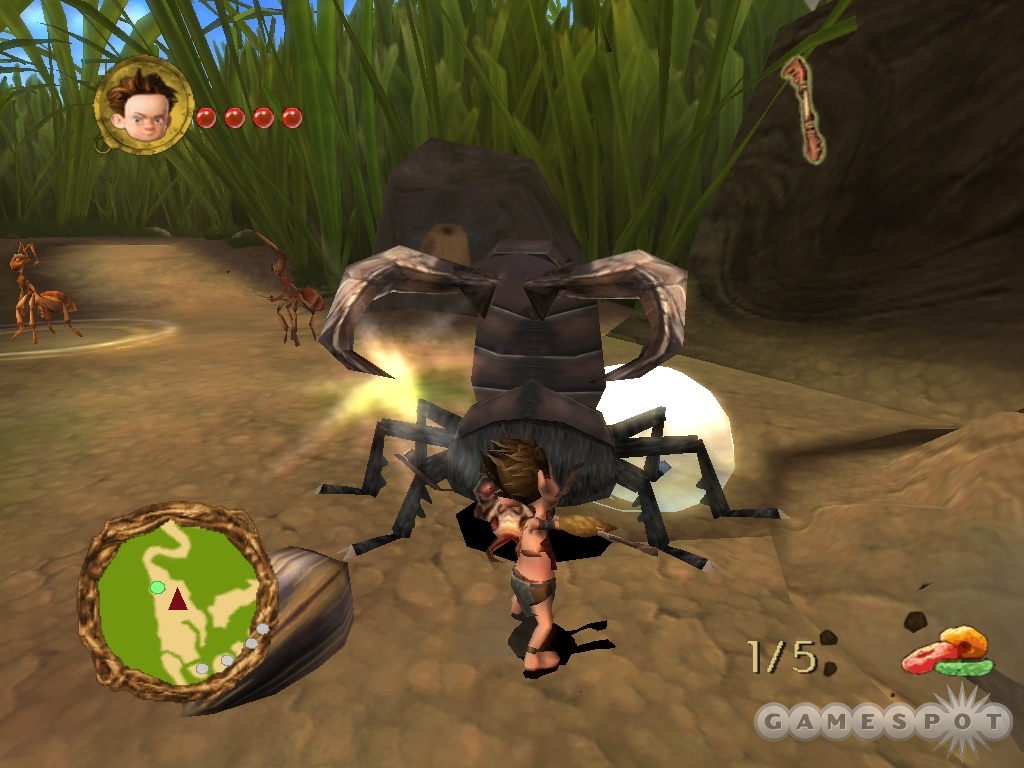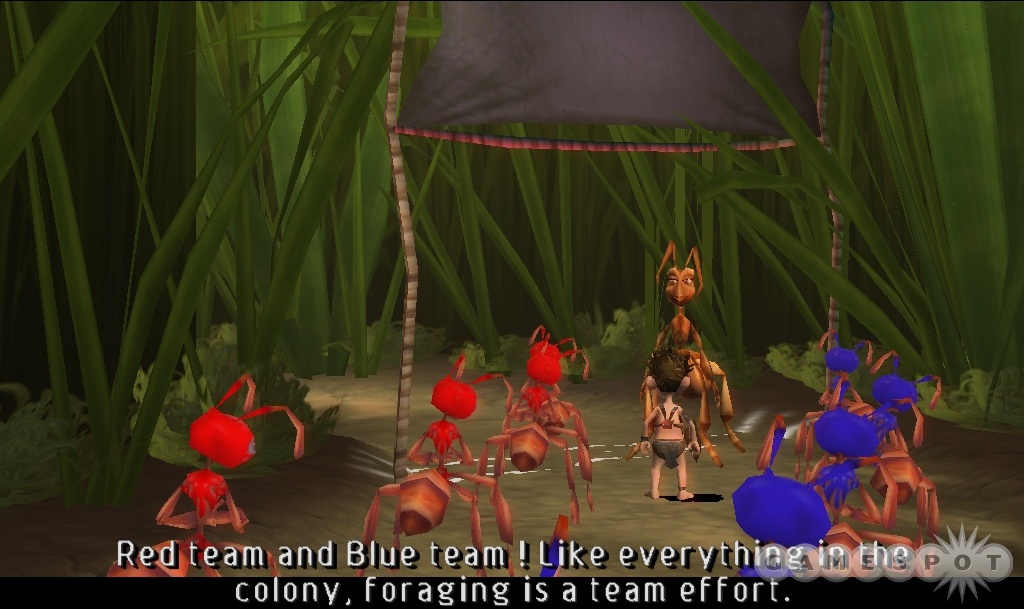Like many movie tie-ins, the video game rendition of The Ant Bully is a far cry from the feature film that it's based on. This 3D adventure game tries to expand on the movie by putting players through a sequence of missions that delve into what Lucas, the insect-sized boy, went through off camera to learn the ants' ways, but it mostly succeeds at showing why events such as these weren't portrayed in the movie in the first place. Nearly every mission involves fetching items or fighting the same enemies over and over again. Moreover, the noninteractive scenes that accompany each mission spend more time preaching the story's morals than they do developing the characters or building toward an exciting conclusion.

Regarding the story, the game and the movie take place in the same time period. Both center around the exploits of a young boy named Lucas, who is reduced to miniscule proportions by a magic potion. The movie follows Lucas's story from a social perspective, giving the viewer insight into the ants' hierarchy as he works his way up from slaving in the mines to fighting alongside the soldiers to stop various predators. At various points in the movie, we see Lucas use the ants' tools and abilities to outwit his opponents and save the day. The game, meanwhile, takes a hands-on approach to telling Lucas' story. It shows how Lucas acquired those tools and learned all of those tricks. Apparently, the process involved completing 20-odd missions tasked to him by the various leaders of the colony, because those missions are what you have to do in this game.
The play mechanics and controls are about what you'd expect from any game like this. The basic idea here is that you need to explore the environment, find the items you're looking for, and pummel any enemies that cross your path. For exploration's sake, Lucas can run and roll, and he can perform a number of contextual abilities when he's close to specific objects and spots in the environment. When you run off a ledge, Lucas will jump automatically. When you're next to a marked wall, a small rock, or a rose petal, you can push the action button, and Lucas will climb the wall, hoist the rock, or use the rose petal like a glider. In some spots, he can call together nearby ants to form useful structures, such as bridges, catapults, or battering rams. To deal with enemies, you can make use of any of Lucas's four weapons. The wooden stick can be used to attack enemies up close, while sticky silk shooters, dart guns, and bombs let you deal with enemies at a distance.
Various flaws become apparent once you get into the habit of fighting multiple enemies. The controls are sometimes slow to respond and the lock-on isn't always reliable, which can make it easy to miss shots and waste ammo. The hit detection is unpredictable, to the point that Lucas's attacks will sometimes pass through an enemy, or an enemy's attack will pass through Lucas, without doling out damage. This is nice when you're the beneficiary but not so nice when you're sandwiched between two ferocious purple spiders. Also, for some bizarre reason, Lucas doesn't jump as high in the PC version of the game, so you really have to line up your leaps in that version. These flaws are unfortunate, but they're not too troublesome, since much of the time you'll have lobbed a seed bomb into a crowd of spiders long before you get up close and personal with them.
What kills the game, ultimately, is how the missions themselves are structured. They all feel the same. Supposedly, by speaking to one of the four caste leaders, you'll be sent on a mission involving rescue, scouting, foraging, or all-out combat. In reality, nearly every mission either involves collecting a bunch of esoteric items or fighting the same cookie-cutter enemies over and over again. A person can only see the same spiders and wasps so often. The game does throw a couple of boss stages into the mix, and you're always free to visit the areas you've previously cleared to hunt for fire crystals at your own pace, but these token nods to adventuring are much too modest to overcome the doldrums brought about by so many lame missions.
They probably could've lessened some of the monotony by making the noninteractive scenes that play between missions at least marginally interesting. Unfortunately, the aftermath of each mission tends to be anticlimactic. The ants cheer, and the spiders or wasps run off. That's pretty much the extent of the game's cinematic aspects. There are a few fleeting bits of humor in the dialogue, but the script generally tends to hammer home the same moral messages of teamwork and honor at every opportunity. While that's nice and all, Bruce Campbell's legendary talents could've been put to better use on dialogue more suited to his comedic range.

In general, the graphics and audio are weak. The characters are colorful and passably animated, but they're not what you'd call detailed or lifelike. The large shrubs and monster-sized insects in the environment succeed in conveying the larger-than-life scale of the insect world, but again, if you stop and look around, you'll notice that the same plants, insects, and objects are recycled constantly. To add insult to injury, the game is easily three years behind the curve when it comes to technical aspects such as polygon count, draw distance, and overall texture quality. As you'd expect, the PC version pushes more polygons and has better lighting effects than the PlayStation 2 and GameCube versions of the game, but the leap in quality isn't as significant as it ought to be. Games such as Jak & Daxter, Super Mario Sunshine, and Beyond Good & Evil all look better than The Ant Bully, and they were released years ago. The audio isn't much better, but at least the generic insect noises, pop-pop sounds, and stereotypical jungle music fit the action without offending the ears.
Unless you're absolutely smitten with what you saw in The Ant Bully movie, you should probably avoid this game. While the game does indeed tell more of the story, it does so in a way that's preachy and uninteresting. Fighting the same half-dozen insects and repeatedly gathering trivial items is no way to spend five or six hours of your life, especially when you can't even rely on the graphics or cinematic scenes to salvage anything from the experience.